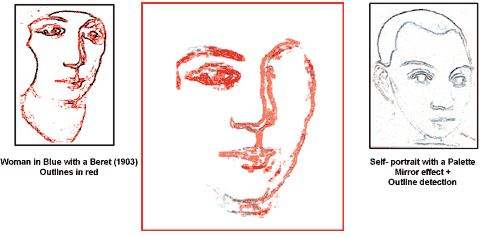| |
From the cutting up of the previous superpositions,
we have reassembled several elements in order to reconstitute a common
face of Woman in Blue with a Beret and Self-portrait with
a Palette of 1906.

Numerous features are identical:
- The eyebrows.
- The almond shaped eyes.
- The sinuous line going from the root of the eyebrow to
the base of the nose.
- The sinuous line with the loops on either side, marking
a thick nose which is Picasso’s.
- The lips that form the mouth which is Picasso’s.
In summary
- Woman in Blue with a Beret is a self -portrait
of Picasso where he projected himself, with maybe the recollection of
the prostitutes in 1901. He was used to this kind of transfiguration.
His own features are at the base of the portrait of Woman in Blue
with a Beret. This statement is particularly striking for the mouth
and the nose.
- In Celestina there are a lot of Picasso’s
features, but there exists a few of the model’s features caught
from life or memorized.
- Celestina and Woman in Blue with a Beret
are « figures - symbols ».
- They have a great deal of similarities and a large number
of common points with Self -portrait with a Palette of 1906.
Picasso’s features can be found in almost all his portraits with
different facets. He is the centre, their base. A study carried out
on the portrait of Gertrude Stein by the Metropolitan Museum of New
York comes to the same conclusion.
In Conclusion,
These signs and features are fundamentally Picasso's
and are, basically, his own features. They authenticate,
just as the studies do, these portraits by Picasso.
|
|

|

